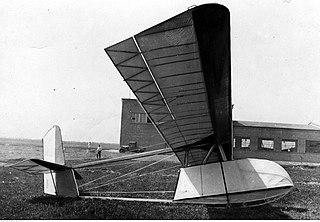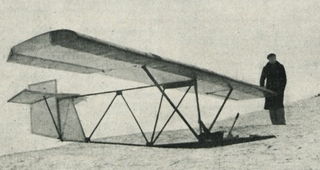Related Research Articles
The A-2 Vautour (Vulture) was a single-seat French glider that was designed by Georges Abrial. It performed well at the Vauville competition of 1925.

The F.V.D. Stehaufchen or Der Dresdener Stehaufchen, later relabelled the Akaflieg Dresden D-B1 Stehaufchen, was an unequal span biplane glider designed and built in Germany in 1921. It flew with some success at the second and third Rhön competitions on the Wasserkuppe and was also used to train pilots.
The Grzmilas Orkan II was a Polish one-off, single-seat sports aircraft. It came second in the second National Lightplane Contest held soon after its first flight, with outstanding take-off and climb characteristics. Its designer and builder continued to use it until 1939.
The Gabriel Śląsk (Silesia) was a Polish light aircraft designed and built by an amateur in the mid-1930s. After two flights the Polish authorities banned further development.
The AMA, named after its designers, was a one-off motor glider built in Poland in the mid-1930s. Its development was abandoned after early tests revealed incurable engine-mounting vibration problems.
The SL.1 Akar (Gnat) was a Polish glider built to compete in the First Polish Glider Contest, held in 1923. It dominated the contest with its pilots achieving first and second places.
The Błażyński Polon was a competitor in the First Polish Glider Contest, held in the late summer of 1923. It was of advanced aerodynamical design, showed promise but was wrecked before the best winds arrived.
The Kubicki Ikub I, which some sources refer to as the Ikub Ia, was a Polish glider built to compete in the first Polish glider contest. It was placed third behind two Karpiński SL.1 Akars but gained the second prize and also made what may have been the first nighttime glider flight.
The Jach Żabuś was a Polish glider designed to compete in the 1923 First Polish Glider Contest. It lacked vertical flying surfaces, had an unusual control system and made only one short flight. Rebuilt with conventional tail and controls, it won the distance flown prize at the second contest, held in 1925.

The Kućfir Pirat was a Polish glider designed to compete in the 1923 First Polish Glider Contest. Though it had flown earlier it could manage only one very brief flight at the Contest, ending in a destructive crash.
The Bohatyrew Miś was a Polish glider which in 1925 won the Second Polish Glider Contest.
The Śpiesz się powoli, was a Polish glider which gained second place at the Second Polish Glider Contest, held in 1925.
The Działowski Bydgoszczanka, named after Bydgoszcz, the city where it was built in 1925, was a Polish glider designed to compete in the Second National Gliding Contest.
The Czerwiński CW II,, was a Polish open frame glider. In 1929 it set a new national duration record and flew successfully until the end of 1931, when several major structural and aerodynamic modifications improved its performance. A simpler, lighter version, the CW III,, was designed and built in parallel with it and became Poland's first production glider.

The Czerwiński CW 8 was a mid-1930s Polish open-frame basic training glider. Its design was advanced and its price low, but its stalling characteristics were too dangerous for beginners, so the thirty-plus examples completed were rapidly withdrawn from use. Two were subsequently modified, one with greater span and the other with a small engine.

The Czajka (transl. Lapwing) or Kocjan Czajka after its designer was a Polish secondary training glider which was in continuous production from 1931 to the start of World War II. More than 160 were completed in Warsztaty Szybowcowe in Warsaw.

The Warsztaty Szybowcowe Wrona, or Kocjan Wrona after its designer, was the most numerous and widely used Polish pre-war primary glider.

The Warsztaty Szybowcowe Sroka, or Kocjan Sroka after its designer, was a Polish intermediate training glider. About sixty were built between 1934 and 1939.

The Jaworski WJ 3 was a Polish, low cost primary glider first flown in 1936. It did not prove popular and only one was built.

The Muraszew-Tomaszewski MT 1 was a single seat flying boat training glider designed and built in Poland in the 1930s. It was successfully tested with take-offs from rivers, sea and land but no government funding followed and only one was completed.
References
- 1 2 3 4 Cynk, Jerzy (1971). Polish Aircraft 1893-1939 . London: Putnam Publishing. p. 675. ISBN 0-370-00085-4.
- 1 2 3 "S-1, 1925". Samolotypolskie.pl. Retrieved 13 August 2018.